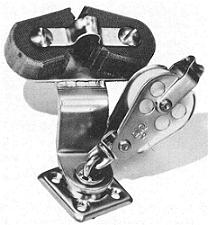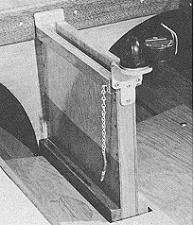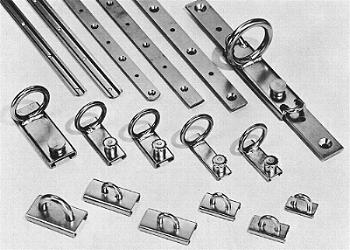Rigging Small Sailboats
Chapter 6 .....deck fittings
Page 3
 FIG. 6-7 - This is the deluxe mainsheet cam cleat which swivels, allows a fairlead to the main sheet and belays the line so it does not have to be hand held. photo courtesy Schaefer Marine Products |
 FIG. 6-8 - A swiveling mainsheet cam cleat mounted on a bracket on the daggerboard trunk. The mainsheet passes through the into the cam cleat. The looped wire (right) prevents the line from jumping out of the cleat when released. Note the pin on the daggerboard trunk to "lock" the daggerboard in position. |
CAM CLEATS
A CAM CLEAT is a fitting used to belay (halt and secure) a line. The line passes between two serrated cams which allow the line to be pulled through in only one direction. To release the line, it is pulled up and out of the cams. Fig. 6-6 shows a typical cam cleat. Cam cleats often have a fairlead to guide the line into the cams. Regular cam cleats are normally mounted flat to the deck. A cam cleat arrangement is often attached integrally to a fiddle block for adjusting a boom vang or main sheet. A deluxe fitting is a swiveling mainsheet cam cleat (Figs. 6-7 and 6-8) which comes with a block and a fairlead to change direction of the mainsheet, leading it into the cam cleat. The benefit of this fitting is that the helmsman need not hold onto the mainsheet, but it can he released in an instant by giving it a yank upwards. It also swivels so the sheet will be at hand on any tack.
 FIG. 6-9 - A selection of tracks and slides. Some are of stamped metal while others are extruded; aluminum, stainless steel, and plastics are common materials used. The slides shown are designed to fit the tracks. |
TRACKS
TRACKS are formed metal or plastic rails on which fittings can be attached to allow them to move. A piece of track is used where it is desirable to have the position of the fitting adjustable. Tracks can also be used to attach the sail to the spars in some cases. Tracks are commonly used for the jib and Genoa sheet leads which pass through fittings attached to slides moving on the tracks. These fittings can range from a fairlead slide, or a block on a slide, or even a cam cleat on a slide. Some typical slides and tracks are shown in Fig. 6-9. Tracks are also used for the clew outhaul slide and for sliding goosenecks. When the gooseneck mounts to a slide, a downhaul is used as well to allow for adjustment. Jib and Genoa tracks, and tracks used for travelers should be fitted with stops at the ends to prevent the fittings from sliding off the tracks. In selecting tracks, remember that the fitting to be used must be made to fit the type track being used.
CLEATS, FAIRLEADS, AND EYESCLEATS (Fig. 3-19) are fittings to which lines are belayed and secured. With small sailboats, a common cleat is a JAM CLEAT. These allow a line to be taken through or turned around the jam cleat in such a manner so that it will not slip free. Jam cleats are commonly used to secure halyards and sheets. Many kinds of patented-type jam mechanisms are also available which are often referred to as "jam cleats" because they perform the same function.
FAIRLEADS are actually any fittings which give a "fair lead" to any line (see Fig. 6-2). Fairleads are usually eye-shaped fittings which minimize or prevent chafing of the line which passes through it. Fair fairlead (left) and leads usually change the direction of the line passing through them as well. As noted previously, a block can be used to change the direction of a line also, thereby making it a type of "fairlead" too. Fairleads can be fixed to the deck, swiveling, or mounted on tracks.
EYES such as PAD EYES, DEAD EYES, and EYE STRAPS are used to secure a line or a fitting to the boat (see Fig. 6-2). Many types are available to fulfill a variety of functions. Pad eyes, when fitted with a shackle, can secure a block to the hull and allow it to adopt the right position for proper sheet lead. Deadeye straps are often used to secure a traveler line or mainsheet to the hull. The traveler or mainsheet is knotted to prevent it from coming through the eyes.